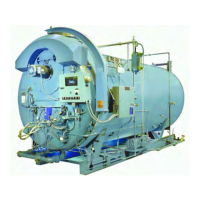Chapter 3 — Waterside Care and Requirements
3-16 Part No. 750-184
- again to prevent uneven contraction and temperature differentials
that can cause expanded tubes to leak. Draining the unit too quickly
may cause the baking of deposits that may be present on the
heating surfaces. Some heat, however, may be desirable to dry out
the interior of the boiler.
If the internal inspection is being made at the request of an
authorized inspector, it is well to ask the inspector observe the
conditions prior to cleaning or flushing of waterside surfaces.
Be certain that a supply of manhole and handhole gaskets is
available, along with any other gaskets or items needed to place the
unit back into operation after inspection.
Have available information on the boiler design, dimensions,
generating capacity, operating pressure or temperature, time in
service, defects found previously, and any repairs or modifications.
Also have available for reference records of previous inspections.
Be prepared to perform any testing required by the inspector
including a hydrostatic test.
After proper cooling and draining of the vessel, flush out the
waterside with a high pressure water hose. Remove any scale or
deposits from the waterside surfaces and check for internal or
external corrosion and leakage.
The fireside surface should also be thoroughly cleaned so that metal
surfaces, welds, joints, tube ends, fittings and any previous repairs
can be readily checked.
Be sure that steam valves, and valves to expansion tank (hot water),
feedwater valves, blow-off valves, all fuel valves, valves to
expansion tank, and electrical switches are shut off prior to opening
handholes, manhole and front or rear doors. Adequately vent the
pressure vessel prior to entry.
Clean out the low-water cutoff piping, the water level controls and
cross-connecting pipes. Replace the water gauge glass and clean
out the water cocks. Also check and clean the drain and the
blowdown valves and piping.
Check all water and steam piping and valves for leaks, wear,
corrosion, and other damage. Replace or repair as required.
I. PREPARATION FOR EXTENDED LAY-UP
Many boilers used for heating or seasonal loads or for stand-by
service may have extended periods of non-use. Special attention
must be given to idle boilers so that neither waterside nor fireside
surfaces are allowed to deteriorate from corrosion.
Too many conditions exist to lay down definite rules. There are two
methods of storage: wet or dry. Your local Cleaver-Brooks authorized
representative can recommend the better method depending upon
circumstances in the particular installation.

